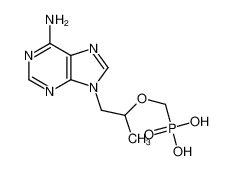Recommended Suppliersmore
-

tenofovir (anhydrous) Purity: 99%Lead Time: - -

tenofovir (anhydrous) Purity: >=98%Lead Time: 1 Day -

tenofovir (anhydrous) Purity: 99.50%Lead Time: 2 Day -

tenofovir (anhydrous) Purity: 99%Lead Time: 1 Day -

tenofovir (anhydrous) Purity: 99%Lead Time: 2 Day
tenofovir (anhydrous) |
|
| CAS No.: | 147127-20-6 |
|---|---|
| Synonyms: | |
| Formula: | C9H14N5O4P |
| Exact Mass: | 287.07800 |
| Molecular Weight: | 287.21200 |
| PSA: | 146.19000 |
| LogP: | 0.53000 |
| Reference Price: | $572/kg Post Buying Request |
|
Description
Feedback
|
Microbicides for sexually transmitted diseases are pharmacologic agents and chemical substances that are capable of killing or destroying certain microorganisms that commonly cause human infection (for example, the human immunodeficiency virus).
Microbicides are a diverse group of chemical compounds that exert their activity by a variety of different mechanisms of action. Multiple compounds are being developed and tested for their microbicidal activity in clinical trials. Microbicides can be formulated in various delivery systems including gels, creams, lotions, aerosol sprays, tablets or films (which must be used near the time of sexual intercourse) and sponges and vaginal rings (or other devices that release the active ingredient(s) over a longer period). Some of these agents are being developed for vaginal application, and for rectal use by those engaging in anal sex.
Although there are many approaches to preventing sexually transmitted diseases in general (and HIV in particular), current methods have not been sufficient to halt the spread of these diseases (particularly among women and people in less-developed nations). Sexual abstinence is not a realistic option for women who want to bear children, or who are at risk of sexual violence. In such situations, the use of microbicides could offer both primary protection (in the absence of condoms) and secondary protection (if a condom breaks or slips off during intercourse). It is hoped that microbicides may be safe and effective in reducing the risk of HIV transmission during sexual activity with an infected partner.[full citation needed]
Microbicides are a diverse group of chemical compounds that exert their activity by a variety of different mechanisms of action. Multiple compounds are being developed and tested for their microbicidal activity in clinical trials. Microbicides can be formulated in various delivery systems including gels, creams, lotions, aerosol sprays, tablets or films (which must be used near the time of sexual intercourse) and sponges and vaginal rings (or other devices that release the active ingredient(s) over a longer period). Some of these agents are being developed for vaginal application, and for rectal use by those engaging in anal sex.
Although there are many approaches to preventing sexually transmitted diseases in general (and HIV in particular), current methods have not been sufficient to halt the spread of these diseases (particularly among women and people in less-developed nations). Sexual abstinence is not a realistic option for women who want to bear children, or who are at risk of sexual violence. In such situations, the use of microbicides could offer both primary protection (in the absence of condoms) and secondary protection (if a condom breaks or slips off during intercourse). It is hoped that microbicides may be safe and effective in reducing the risk of HIV transmission during sexual activity with an infected partner.[full citation needed]
|
Properties
Feedback
|
|
| Appearance & Physical State: | White Crystalline Solid |
|---|---|
| Density: | 1.79 g/cm3 |
| Melting Point: | 276-280ºC |
| Boiling Point: | 616.1ºC at 760 mmHg |
| Flash Point: | 326.4ºC |
| Water Solubility: | 13.4 mg/mL (25 ºC) |
|
Safety Info
Feedback
|
|
| RTECS: | DB8930000 |
|---|---|
| Hazard Class: | 8 |
| Safety Statements: | S22; S26; S27; S36/37/39 |
| HS Code: | 2933990090 |
| Packing Group: | III |
| WGK Germany: | 3 |
| RIDADR: | UN 3261 8/PG 2 |
| Risk Statements: | R34 |
| Hazard Codes: | C |
NMR Spectrum
Synthesis Route Total: 11 Synthesis Route

- ~89%

- View Detail

- ~23%

- View Detail
Precursor and Product
- Precursor:
-

-

-

-

-

-

- ……
- Total: 11
- Product:
-

-

- Total: 2
- Upstream information
- Tenofovir diethyl ester; fumaric acid; tenofovir (anhydrous); diethoxyphosphorylmethyl 4-methylbenzenesulfonate; (R)-(+)-9-(2-Hydroxypropyl)Adenine; 6-aminopurine; Tenofovir diisopropyl ester; diisopropyl (R)-(((1-(6-benzamido-9H-purin-9-yl)propan-2-yl)oxy)methyl)phosphonate; Chloromethyl isopropyl carbonate; ({[(2R)-1-(6-amino-9H-purin-9-yl)propan-2-yl]oxy}methyl)phosphinic acid;
- Downtream information
- tenofovir (anhydrous); tenofovir disoproxil fumarate; Tenofovir alafenamide;









